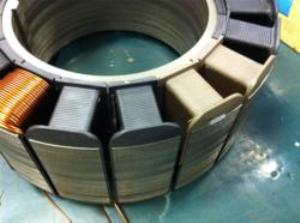DuPont announced that its material science innovations have helped SIM-Drive, a company based in Kawasaki City, Japan, to achieve a breakthrough in electric vehicle (EV) technology. DuPont has collaborated with SIM-Drive to work on the prototype SIM-WIL EV vehicle that includes about 50 new technologies.
 Motor bobbin of DuPont Zytel HTN PPA for new in-wheel electric motor for SIM-WIL EV
Motor bobbin of DuPont Zytel HTN PPA for new in-wheel electric motor for SIM-WIL EV
The prototype was introduced in March 2012 and the latest collaboration has extended the driving range 30% higher than the current mass-produced EV vehicles.
SIM-WIL provides a superior comfort level and greater interior space. In addition, it offers a maximum speed of 180 km/h and sports car acceleration ranging from 0 to 100 km/h in 5.4 s. The prototype EV vehicle has an appealing interior and exterior look, reduced weight and improved reliability and performance with the use of DuPont’s products, including paint, paper, film and high-performance plastics.
High-performance plastics, such as DuPont Zytel HTN PPA, have been used in the in-wheel motor bobbins and a polyimide film called DuPont Kapton in indicator lighting. These materials have helped the Japanese firm to maintain weight lower than today’s EVs. DuPont Zytel HTN PPA is lighter, stronger and more economical than PPS. The polyimide film from DuPont is ideal for high-reliability applications, ranging from Mars Rover to mobile devices, and it eliminates the need for a circuit board.
In addition, DuPont Sorona bio-based polymer is used in the EV’s interior, which helps enhance the environmental footprint. SIM-Drive’s next-generation vehicle also utilizes DuPont Corian for refined touchpoints and DuPont coatings to enhance the aesthetics.
Recently, DuPont has invested in a number of new automotive collaboration centers in Korea, China and India and has also planned to upgrade facilities in Europe and the U.S. These centers are developed to connect academics, strategic partners and customers with over 9,500 scientists and engineers from DuPont across the globe to work on materials-science innovation in order to meet market needs, particularly in renewable materials, lightweighting and vehicle electrification.